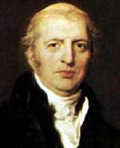 |
Robert Banks Jenkinsonb. 7 Jun 1770, London |
| Ministerial offices: | Commissioner of the Board of Control (28 Jun 1793 - 28 Mar 1799) |
| Master of the Mint (14 Feb 1799 - Feb 1801) | |
| Member of the Board of Trade (14 Mar 1799 - 17 Jul 1799) | |
| Foreign Secretary (20 Feb 1801 - 12 May 1804) | |
| Leader of the House of Lords (Nov 1803 - Feb 1806, Mar 1807 - Apr 1827) | |
| Home Secretary (12 May 1804 - 4 Feb 1806, 25 Mar 1807 - 30 Oct 1809) | |
| Secretary of State for War and Colonies (31 Oct 1809 - 10 Jun 1812) | |
| First Lord Commissioner of the Treasury (8 Jun 1812 - 9 Apr 1827) | |
| Names/titles: | Lord Hawkesbury [1796-1808]; Baron Hawkesbury [from 15 Nov 1803]; 2nd Earl of Liverpool [from 17 Dec 1808] |
| Biography: | |
Robert Jenkinson was born in the family of landowners. His father, Charles Jenkinson, served as Secretary at War (1778-1782) in the North administration. In May 1790 Robert Jenkinson graduated from Christ Church College, Oxford, with a master's degree, and the next month he was elected to Parliament (MP, 1790-1803) as a Tory representative. In 1801 Jenkinson was appointed Foreign Secretary (1801-1804) in the Cabinet of Henry Addington. After serving as Home Secretary (1804-1806) under William Pitt the Younger, he was offered to form a new administration, but refused and became Leader of the Opposition (Jan 1806 - Mar 1807). He succeeded his father as the 2nd Earl of Liverpool in 1808. The assassination of Spencer Perceval (11 May 1812) provoked a governmental crisis, during which the Prince Regent for almost a month could not find appropriate successor. On 8 Jun 1812 the Regent appointed Liverpool First Lord of the Treasury with the authority to form a stronger administration. An excellent administrator, Liverpool sought to centralize Cabinet government, keeping much policy in his own hands through an inner Cabinet. His first great achievement was, with the aid of the Duke of Wellington in the field, to conclude the war with France. The definitive Treaty of Peace with France was signed on 30 May 1814. Another peace treaty, which ended the War of 1812-1814 with the United States, was concluded at Ghent on 24 Dec 1814. Another success of the Liverpool administration was to contain public discontent with the dislocations brought about by the end of the war. During the 1820s, Liverpool was converted to Free Trade and gradually rebuilt prosperity. He supported some social legislation and had clear and concrete views on Parliamentary reform. On the other hand he totally opposed a Bill for the enfranchisement of Catholics introduced in 1821. On 29 Jan 1820 King George III died and was succeeded by the Prince Regent under the name of George IV. His accession was soon followed by the disclosure of the Cato Street Conspirators, who intended to assassinate the Cabinet. In 1825 passage by the House of Commons of another Bill on Catholic emancipation tempted Liverpool to resign, but he continued in office when the emancipation was defeated in the House of Lords. Prematurely exhausted, on 17 Feb 1827 he suffered a severe cerebral hemorrhage, which left him temporarily paralyzed. His incapacity led to his resignation on 9 Apr 1827. He died eighteen months later. Biography source: [1, pp. 104-109] |
|
| | |
| [1] | Englefield, Dermot; Seaton, Janet; White, Isobel (eds.) Facts About the British Prime Ministers: A Compilation of Biographical and Historical Information. New York: The H.W. Wilson Company, 1995. online |
| Image: 2nd Earl of Liverpool, detail of an oil painting by Sir Thomas Lawrence, c. 1796. | |
